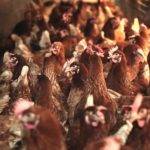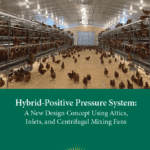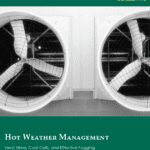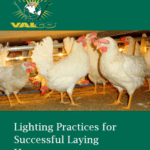
Cage-free Housing: Community Nests or Aviary Systems
The egg industry’s transition to cage-free started in 2008 when the nation’s first cage-free mandate – Proposition 2 – was introduced in California. Initially, cage-free producers chose to use community nesting systems. Community nests provide a lot of space per bird and they are easy to manage. With cage-free demands growing and community nesting systems […]
Read More >
Feathering’s biggest role is to serve as protection from the elements. It’s an insulation factor that keeps birds’ bodies warm so that energy can be better used to lay eggs or grow muscle tissue. But why do birds lose their feathers? The answer is sometimes complex. Factors range from housing structures and equipment, to nutrition […]
Read More >
White Paper – The Practice & Purpose of Minimum Ventilation
The Practice & Purpose of Minimum Ventilation Ventilating poultry barns during cold winter months is a delicate balancing act of preserving warmth and expelling moisture. It’s imperative that heat is retained in the barn so that fuel costs stay low during the cold-weather season; however, heaters and livestock both add abundant moisture and toxic fumes […]
Read More >
Hybrid-Positive Pressure System: A New Design Concept
Hybrid-Positive Pressure System: A New Design Concept Most poultry houses are designed using a negative pressure ventilation program, but free-range facilities must be thought about differently. Because free-range farms must provide outside access for birds, pop-doors are built into the walls. These doors are often required to be open for long periods of time, if […]
Read More >
Hot Weather Management: Heat Stress, Cool Cells, and Effective Fogging
Hot Weather Management Poultry farmers are no strangers to extremes, especially extreme temperatures. Perfect growing conditions might only exist a few days out of the year, and the rest of the time is spent trying to manufacture the perfect environment. Peak summertime temperatures can be detrimental to flocks, so its imperative that effective cooling strategies […]
Read More >
Lighting Practices for Successful Laying Hens
Lighting Practices for Successful Laying Hens Sight is the most important sense for birds, as good eyesight is essential for safe flight, and birds have several adaptations that provide superior visual acuity relative to other vertebrate groups. Eyes share a basic common structure across species with some adaptations befitting evolution. In chickens, the eye […]
Read More >
The Ultimate Poultry Watering Guide
The Ultimate Poultry Watering Guide An effective watering system only performs as well as the farmer knows how to make it. It seems like such a simple thing, but sometimes even the smallest errors can have a detrimental effect on flock performance. Not to worry, we’re here to explain everything that you need to know […]
Read More >
A Guide to Managing Breeder Hens: From brood to lay
Rearing pullets means growers must be aware of all the management practices that make a healthy, reproductive bird. A productive breeder hen must hit a target weight by a particular age and have proper body conformation in order to be stimulated into egg laying. Flock uniformity is crucial to a productive hen house. A flock […]
Read More >
Batch Farrowing: A Renaissance in Swine Production
Commercial swine farming has had a long history, but it’s only more recently we see it beginning to repeat itself. When farming was more concerned with plant crops, farmers kept enough livestock to feed themselves and their neighbors. The pigs were raised with little direct management, left to forage for food, fed leftover scraps and […]
Read More >
The Biosecurity Report – Understanding Biosecurity in Modern Poultry Operations
Biosecurity Report Biosecurity is the prevention and control of pathogenic microorganisms from contacting animal or human populations. In the context of modern poultry production, it is essentially keeping the birds separate from the agents causing the disease. Used properly, biosecurity will also minimize the effect of disease and contain the spread of disease, if found. […]
Read More >
The Modern Hen: A Look at Cage-free Housing Solutions
Egg farmers started bringing chickens indoors in the 1940s and 1950s in order to keep them safe from diseases and predators. Today, the egg industry is facing pressure from animal welfare groups, consumers, and food chains vowing to use only cage-free eggs. The lack of unified guidelines and industry conflict on what “cage-free” really looks […]
Read More >
Implementing Effective Modern Sow Gestation Housing Solutions
Implementing Effective Modern Sow Gestation Housing Solutions Animal husbandry of dry (pregnant) sows in the United States is in the midst of a transition from indoor individual gestation stall housing to indoor loose housing with group pens that enables greater sow socialization, space, movement and choice. Committed to this conversion, many U.S. sow producers are […]
Read More >